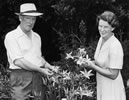Changing attitudes
In the 1970s Muriel Fisher, a suburban gardener in Auckland, and Lawrie Metcalf, a South Island parks horticulturalist, wrote highly influential books on growing native plants. These two books popularised native plants and helped break down the widespread perception that they were drab and difficult to grow. Specialist native nurseries sprang up in response to the growing demand for native plants, and offered a wider selection of plants.
Return of the native
In the mid-1970s many gardeners believed that native plants were fussy, slow growing and dreary. Mark and Esme Dean set out to debunk these myths with talks, articles and displays. By 2005 their plant nursery, Naturally Native, was producing 1 million native plants a year.
During the 1980s native plants started to come into their own. The conservation movement was gathering strength, and there was a lot of publicity about the destruction of native forests. Many New Zealanders realised that they valued their natural heritage, and wanted to recreate or celebrate it by planting natives in their gardens and local areas.
Native gardens aren’t based around colourful, seasonal flowers. Instead, gardeners create year-round interest by contrasting form, texture and foliage colour.
Flower colour
Most New Zealand plants have small, white flowers. The notable exceptions are:
- pōhutukawa (Metrosideros excelsa) – red
- kōwhai (Sophora species) – yellow
- kākā beak (Clianthus species) – red
- Marlborough rock daisy (Pachystegia insignis) – large, white and yellow
- Chatham Island forget-me-not (Myosotidium hortensia) – blue
- Mt Cook lily (Ranunculus lyallii) – large and white.
Form and foliage
Clumped plants with long sword-shaped leaves, such as flaxes (Phormium), Poor Knights lily (Xeronema callistemon), astelia, wild spaniards (Aciphylla), native irises (Libertia), dianella, Machaerina, and some mountain daisies (Celmisia), provide stylish sculptural effects in a border.
Small trees with long, spear-like leaves, such as cabbage trees, lancewoods, turpentine trees (Dracophyllum), juvenile rewarewa and hīnau, are often used as a contrast to large broad-leaved shrubs like rangiora (Brachyglottis repanda), kawakawa (Macropiper excelsum), whau (Entelea arborescens), pukunui (Meryta sinclairii) and puka (Griselinia lucida).
Divaricating shrubs
New Zealand has many small-leaved, wiry, branched shrubs. Known as divaricating shrubs, these have become a feature in wind-swept civic plantings. They include the orange-stemmed Muehlenbeckia astonii, many types of coprosma, and corokia (Corokia cotoneaster), a compact shrub that produces a mass of yellow star-shaped flowers in spring, and bright red berries in summer.
Grasses and sedges
Long overlooked by gardeners, tussock grasses and sedges have become increasingly popular. They are low-maintenance plants that provide texture and colour, rustling and waving in the wind.
New Zealand’s largest grasses, known as toetoe, are closely related to the South American pampas grasses. Their dense tussocks grow 2–5 metres tall, with spires of feathery plumes when in flower. Toetoe withstand a range of soil conditions and are useful as shelter hedging.
The snow tussocks (Chionochloa species) form smaller, tidier tussocks around 0.5–1 metre tall. Chionochloa flavicans is probably the most widely planted. It has attractive, light-green flowering plumes that last for months.
A number of grasses and sedges provide colour in the garden. Strong shades of red are found in:
- red tussock (Chionochloa rubra)
- flowering wind grass (Anemanthele lessoniana)
- the hook grasses Uncinia rubra and U. egmontiana .
Orange and tan:
- pīngao (Desmoschoenus spiralis)
- Carex buchananii and C. flagellifera.
Blue-greys:
- blue grass (Elymus solandri)
- Festuca coxii (a Chatham Island endemic)
- two fine-leaved grasses, Poa astonii and Poa colensoi.

